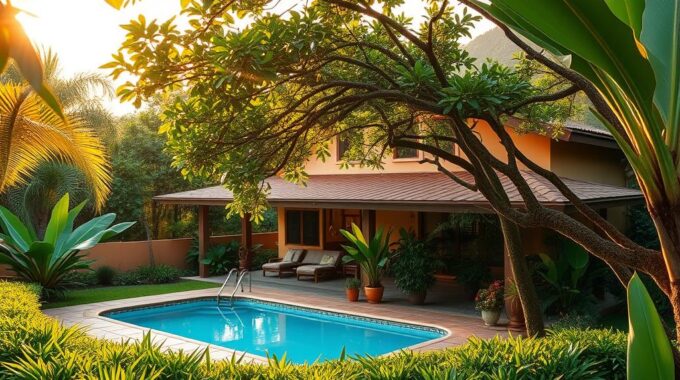As a hub for international workers and service providers, Costa Rica has introduced Law No…

Costa Rica Retirement Laws: Expert Guide for Retirees With CRIE.cr.
Costa Rica Immigration Experts (CRIE) has helped many people make Costa Rica their home. For over 20 years, we’ve guided people through the residency process. We are one of the most experienced firms in the country. If you’re thinking about retiring there, we can help you understand the laws and requirements.
Many Americans choose to retire in Costa Rica, and it’s not hard to understand why. It’s a beautiful country with a warm climate and amazing scenery. Plus, the cost of living is usually lower than in the U.S. or Europe. But, getting residency can be tricky. Our experts at CRIE.cr offer step-by-step help for a successful application.
Key Takeaways
- Costa Rica offers several residency options for retirees, including the Pensionado Program, Rentista Program, and Investment Program.
- The Pensionado Program requires a minimum monthly income of $1,000, while the Rentista Program requires $2,500 per month.
- Permanent residency in Costa Rica grants individuals the right to live, work, access healthcare, and invest in the country.
- CRIE.cr is a trusted expert in navigating Costa Rica’s retirement laws and residency requirements, ensuring a successful outcome for clients.
- The cost of living in Costa Rica is generally lower than in many Western countries, with affordable housing, groceries, and healthcare options.
Understanding Costa Rica’s Pension System
Costa Rica’s pension system offers security and stability for retirees. It has three main parts: a defined-benefit scheme, a capitalization regime, and a non-contributory system. Knowing how this system works is vital for those planning to retire in Costa Rica.
Defined-Benefit Scheme
In Costa Rica’s defined-benefit scheme, retirees get a set monthly payment. This payment is based on their years of work and salary. To get this pension, people need to have contributed for at least 300 months. But, even if you haven’t made that many contributions, if you’re over 65 and have contributed for at least 180 months, you can get a smaller pension.
Capitalization Regime
The country also has a capitalization regime. This lets workers save in personal accounts. The money they save is invested. This creates another source of income for them when they retire. This system makes retirement savings more flexible and controllable for individuals.
Non-Contributory Pension System
The non-contributory pension system helps those who haven’t paid into the other schemes enough. It gives a basic monthly pension to qualifying citizens. This ensures everyone has some financial support in their old age.
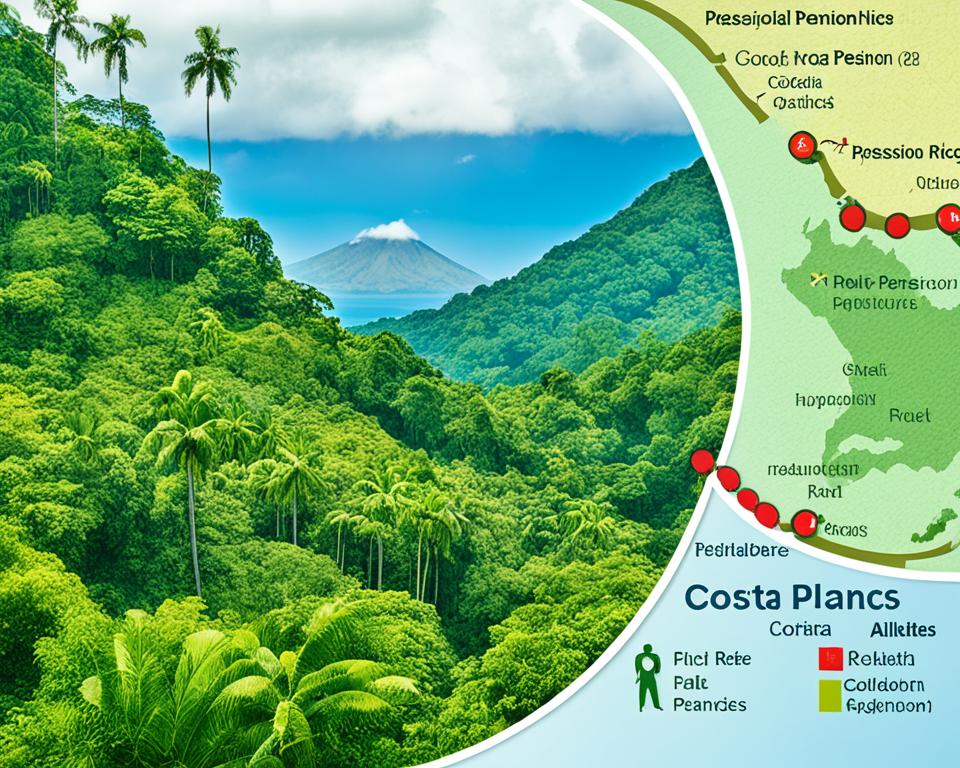
Residency Options for Retirees
Costa Rica has three main ways for retirees to get residency. These are the Pensionado Program, the Rentista Program, and the Inversionista Program. They fit different needs and money situations for those wanting to retire in this Central American beauty.
Pensionado Program
This program is for retirees with at least $1,000 a month from a pension or other steady source. It gives a two-year residency, which is renewable. It also includes discounts on things like transport, utilities, and fun outings.
Rentista Program
Retirees with a minimum of $2,500 monthly income can consider the Rentista Program. It’s more flexible than the Pensionado one. It provides a two-year residency that can be renewed, allowing dependents up to 24 years to join you.
Inversionista Program
The Inversionista Program caters to retirees wanting to invest in Costa Rica. It needs a $200,000 investment in a local business or real estate. This also leads to a two-year renewable residency, aiding in Costa Rica’s growth while enjoying life there.
All these programs offer a great life in Costa Rica. They include top-notch healthcare, a network of friendly locals and others from around the world. With the right help, getting residency can be easy. This sets up a fantastic retirement in Costa Rica.
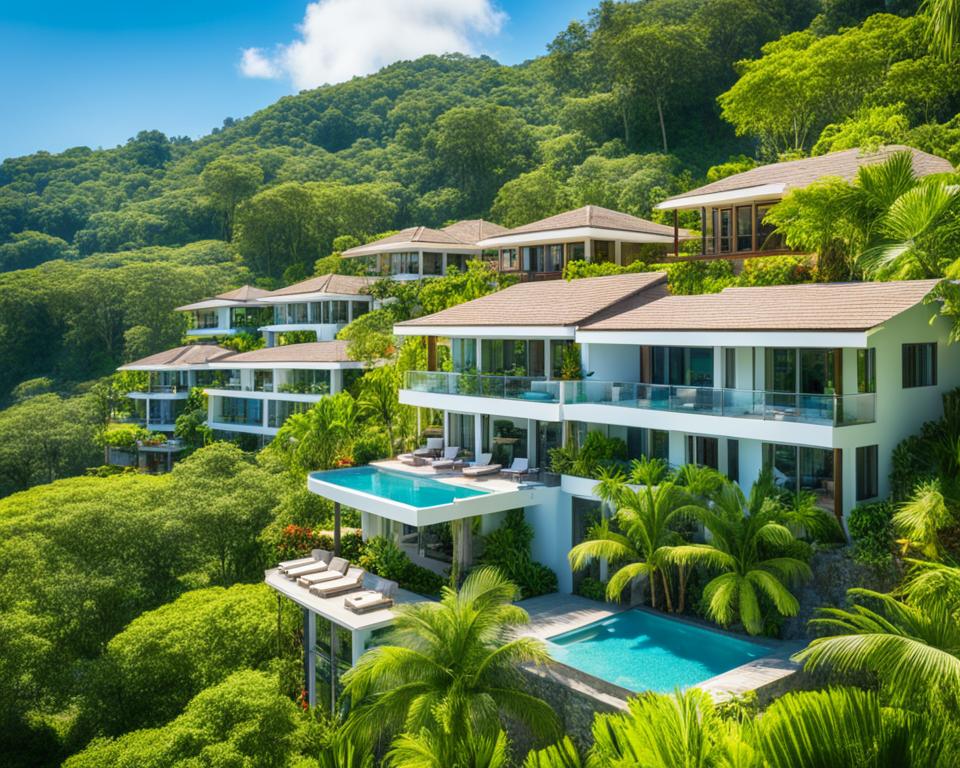
Costa Rica Retirement Laws
Thinking about retiring in Costa Rica? It’s key to know about the pension and retirement laws there. The country has a few different pension programs. These include a defined-benefit scheme, a capitalization regime, and a no-contributions pension system.
To get an old-age pension in Costa Rica, you need to have paid at least 300 months of contributions. Yet, there’s a chance for a pension even if you’ve only paid 180 months. This option is for those 65 or older. These costa rica retirement laws are very important. They help decide who can retire in Costa Rica and how. They also influence the understanding costa rican retirement legislation.
| Pension System Component | Description |
|---|---|
| Defined-Benefit Scheme | Requires a minimum of 300 months of contributions for an old-age pension |
| Capitalization Regime | Allows for a proportional pension with at least 180 contributions and age 65 or older |
| Non-Contributory Pension System | Provides a pension for those who do not meet the minimum contribution requirements |
By learning about Costa Rica’s retirement laws, people can plan better. They’ll understand the rules and regulations for retirement in costa rica more easily. This can lead to a smooth move into retirement in this beautiful country.
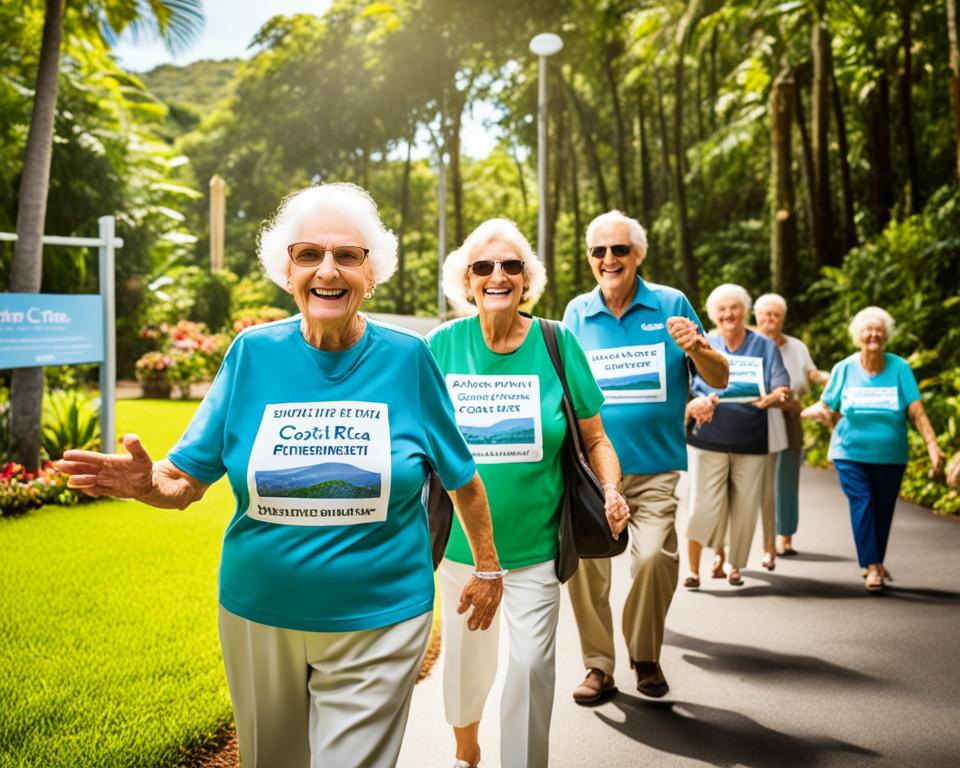
Financial Planning for Retirement in Costa Rica
Planning for retirement in Costa Rica requires using various financial tools and strategies to maximize your savings. Ensure a secure future by focusing on two key areas: employer-sponsored retirement accounts and individual retirement accounts (IRAs).
Employer-Sponsored Retirement Accounts
Costa Rican employers often have 401(k) or similar retirement plans. These allow you to put aside part of your pre-tax income. Using these employer-sponsored retirement accounts in Costa Rica helps you grow your retirement savings. You might also get benefits like employer matching and tax-deferred growth.
Individual Retirement Accounts (IRAs)
IRAs are another great option for financial planning for retirement in Costa Rica. You can choose between a traditional or Roth. These accounts offer tax advantages, aiding in maximizing your retirement savings. They are key to a secure retirement in Costa Rica.
Getting advice from a financial advisor experienced in individual retirement accounts (IRAs) in Costa Rica is a smart move. They can offer customized suggestions. This will help you ensure a comfortable, fulfilling retirement in this beautiful country.
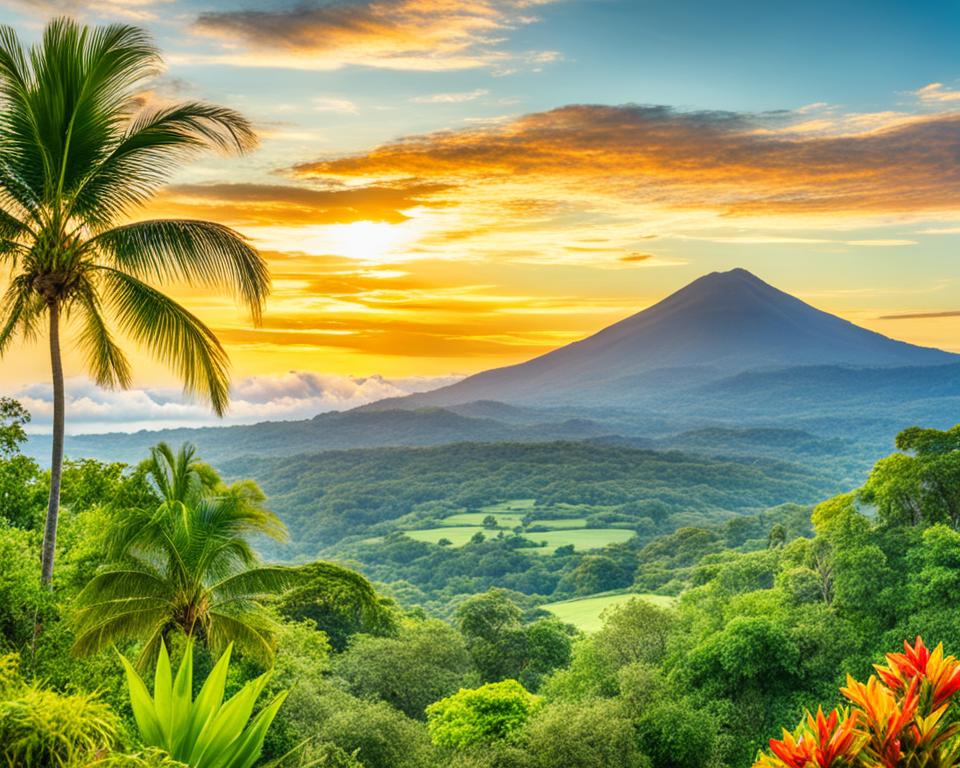
Healthcare for Retirees in Costa Rica
Retirees in Costa Rica highly value the country’s universal healthcare system, called Caja. This service ensures they get top-notch medical care without high costs. They only pay a small monthly fee based on what they earn.
This system means retirees don’t have to worry about setting aside money for healthcare. It gives peace of mind and helps save money for other things.
Universal Healthcare System (Caja)
Caja is very well-respected in Costa Rica. It gives complete health coverage to everyone, including retirees. The amount you pay each month depends on your income, ranging from 7 to 11 percent.
Because of Caja, retirees in Costa Rica can get medical care at a very low cost. They won’t have to spend a lot of money from their own pockets.
Caja offers top-quality care. Three private facilities in Costa Rica’s Central Valley have international certifications. A general visit to the doctor costs about $50 and visiting a specialist is around $80. This makes healthcare very affordable for retirees.
Costa Rica’s healthcare is also known for helping people live longer. In the Nicoya Peninsula, people live to 100 more often than in the United States. Plus, they spend a lot less on medical care. This shows how good and accessible Caja’s healthcare really is, especially for older people thinking of moving to Costa Rica.
Cost of Living for Retirees in Costa Rica
Costa Rica is a great spot for retirees looking for a budget-friendly place. Here, housing costs start from $330 and can go up to $2,000 monthly, depending on the place’s size and location. The expense for groceries, utilities, and getting around is also quite low, which is good news for those on a fixed retirement income. This gives retirees the chance to live a comfortable life in Costa Rica without worrying too much about their budget.
Housing Costs
Living costs for retirees in Costa Rica differ widely, with homes ranging from $330 to $2,000 a month. This means there’s something for everyone, be it a small apartment or a big house. The varied housing market in Costa Rica helps retirees make the most of their money during retirement.
Food and Utilities
Buying food and paying for utilities in Costa Rica is often less expensive than in many other places. This includes affordable fresh produce, dairy products, and more, making it easy for retirees to eat well. The costs for electricity, water, and internet are also budget-friendly, adding to a retiree’s ease of living in Costa Rica.
Transportation Expenses
Getting around in Costa Rica is quite economical for retirees. They can choose from public buses, taxis, and services like Uber. The country’s good road system and pleasant weather are bonuses. They make exploring in a car or on a bicycle even more appealing and affordable for retired individuals in Costa Rica.

Navigating the Residency Process
Getting residency in Costa Rica is a tough nut to crack. It’s best to get help from folks who know this inside out, like Costa Rica Immigration Experts (CRIE). They offer tailored help for your residency application. This means making sure your papers are right and walking you through what you need to do, especially if you’re retiring. With their help, the whole process can become much smoother, and you’re more likely to get that residency.
Documentation Requirements
The stuff you need to apply for residency in Costa Rica can be a lot. You have to have all the documents in their original form. This includes a clean criminal record check from the last six months. You’ll also need eight passport photos for each person applying. If your documents are from another country, they need to be validated by the Costa Rican consulate unless your country is in the Apostille Convention.
Working with Immigration Experts
Letting Costa Rica Immigration Experts (CRIE) help you through the process is a smart move. They can guide you on the different residency paths, help with getting your documents ready, and ensure everything is up to snuff for your application. Their experience can help you sidestep the traps and difficulties of getting residency, meaning you can focus more on getting settled in your new home in Costa Rica.
Conclusion
Ending this, Costa Rica Immigration Experts (CRIE) stands as a top choice for retirees dreaming of Costa Rica. They bring over 20 years of know-how to help thousands smoothly move here. People aiming to retire in Costa Rica find them invaluable.
The allure of Costa Rica’s stunning scenes, pleasant weather, and affordable cost of living calls to many American retirees. Getting help from pros like CRIE makes the residency application process smoother. This way, retirees can readily enjoy the perks of living their dream.
CRIE offers a wide range of immigration services. They help with legalities, get necessary documents, and provide personalized help. This allows retirees to confidently tackle Costa Rica’s residency maze. Thanks to CRIE, retirees look ahead to a joyful life in this exotic land.
FAQ
What is the pension system like in Costa Rica?
The pension system in Costa Rica has three parts. These are a defined-benefit scheme, a capitalization regime, and a non-contributory pension system. For an old-age pension, people must have paid for 300 months. But, if someone hasn’t paid for 300 months, they can still get some pension if they’re 65. They just need to have paid for 180 months.
What are the main residency options for retirees in Costa Rica?
Costa Rica has three big residency choices for retirees. These are the Pensionado Program, the Rentista Program, and the Inversionista Program. For the Pensionado Program, retirees need a What is the pension system like in Costa Rica?The pension system in Costa Rica has three parts. These are a defined-benefit scheme, a capitalization regime, and a non-contributory pension system. For an old-age pension, people must have paid for 300 months. But, if someone hasn’t paid for 300 months, they can still get some pension if they’re 65. They just need to have paid for 180 months.What are the main residency options for retirees in Costa Rica?Costa Rica has three big residency choices for retirees. These are the Pensionado Program, the Rentista Program, and the Inversionista Program. For the Pensionado Program, retirees need a ,000 monthly income. The Rentista Program requires a ,500 monthly income. The Inversionista Program is for retirees who want to invest. They need to put 0,000 into a business or real estate in Costa Rica.How can retirees maximize their retirement savings in Costa Rica?Retirees should make the most of 401(k) plans and IRAs in Costa Rica. These accounts help save tax-free money for the future. Adding to these accounts regularly boosts savings. This way, retirees can have a steady income in their retirement.What is the healthcare system like for retirees in Costa Rica?Costa Rica offers a universal healthcare system called Caja. This system covers medical needs at a low cost based on income. The medical services are top-notch. This means retirees don’t have to worry about huge medical bills. So, they can relax knowing their health needs are taken care of.What is the cost of living like for retirees in Costa Rica?Retiring in Costa Rica is budget-friendly. Rent can be as low as 0 or as high as ,000 a month. The prices for groceries, utilities, and getting around are also very reasonable. Thanks to this, retirees can live well in Costa Rica without spending too much.How can retirees navigate the residency process in Costa Rica?Getting residency in Costa Rica might seem tough. But, it gets easier with help from experts like Costa Rica Immigration Experts (CRIE). They offer tailored help with the residency paperwork. This ensures a smooth process. Having an expert to guide through the requirements boosts the chances of getting approved.,000 monthly income. The Rentista Program requires a ,500 monthly income. The Inversionista Program is for retirees who want to invest. They need to put 0,000 into a business or real estate in Costa Rica.
FAQ
What is the pension system like in Costa Rica?
The pension system in Costa Rica has three parts. These are a defined-benefit scheme, a capitalization regime, and a non-contributory pension system. For an old-age pension, people must have paid for 300 months. But, if someone hasn’t paid for 300 months, they can still get some pension if they’re 65. They just need to have paid for 180 months.
What are the main residency options for retirees in Costa Rica?
Costa Rica has three big residency choices for retirees. These are the Pensionado Program, the Rentista Program, and the Inversionista Program. For the Pensionado Program, retirees need a
FAQ
What is the pension system like in Costa Rica?
The pension system in Costa Rica has three parts. These are a defined-benefit scheme, a capitalization regime, and a non-contributory pension system. For an old-age pension, people must have paid for 300 months. But, if someone hasn’t paid for 300 months, they can still get some pension if they’re 65. They just need to have paid for 180 months.
What are the main residency options for retirees in Costa Rica?
Costa Rica has three big residency choices for retirees. These are the Pensionado Program, the Rentista Program, and the Inversionista Program. For the Pensionado Program, retirees need a $1,000 monthly income. The Rentista Program requires a $2,500 monthly income. The Inversionista Program is for retirees who want to invest. They need to put $200,000 into a business or real estate in Costa Rica.
How can retirees maximize their retirement savings in Costa Rica?
Retirees should make the most of 401(k) plans and IRAs in Costa Rica. These accounts help save tax-free money for the future. Adding to these accounts regularly boosts savings. This way, retirees can have a steady income in their retirement.
What is the healthcare system like for retirees in Costa Rica?
Costa Rica offers a universal healthcare system called Caja. This system covers medical needs at a low cost based on income. The medical services are top-notch. This means retirees don’t have to worry about huge medical bills. So, they can relax knowing their health needs are taken care of.
What is the cost of living like for retirees in Costa Rica?
Retiring in Costa Rica is budget-friendly. Rent can be as low as $330 or as high as $2,000 a month. The prices for groceries, utilities, and getting around are also very reasonable. Thanks to this, retirees can live well in Costa Rica without spending too much.
How can retirees navigate the residency process in Costa Rica?
Getting residency in Costa Rica might seem tough. But, it gets easier with help from experts like Costa Rica Immigration Experts (CRIE). They offer tailored help with the residency paperwork. This ensures a smooth process. Having an expert to guide through the requirements boosts the chances of getting approved.
,000 monthly income. The Rentista Program requires a ,500 monthly income. The Inversionista Program is for retirees who want to invest. They need to put 0,000 into a business or real estate in Costa Rica.
How can retirees maximize their retirement savings in Costa Rica?
Retirees should make the most of 401(k) plans and IRAs in Costa Rica. These accounts help save tax-free money for the future. Adding to these accounts regularly boosts savings. This way, retirees can have a steady income in their retirement.
What is the healthcare system like for retirees in Costa Rica?
Costa Rica offers a universal healthcare system called Caja. This system covers medical needs at a low cost based on income. The medical services are top-notch. This means retirees don’t have to worry about huge medical bills. So, they can relax knowing their health needs are taken care of.
What is the cost of living like for retirees in Costa Rica?
Retiring in Costa Rica is budget-friendly. Rent can be as low as 0 or as high as ,000 a month. The prices for groceries, utilities, and getting around are also very reasonable. Thanks to this, retirees can live well in Costa Rica without spending too much.
How can retirees navigate the residency process in Costa Rica?
Getting residency in Costa Rica might seem tough. But, it gets easier with help from experts like Costa Rica Immigration Experts (CRIE). They offer tailored help with the residency paperwork. This ensures a smooth process. Having an expert to guide through the requirements boosts the chances of getting approved.
How can retirees maximize their retirement savings in Costa Rica?
Retirees should make the most of 401(k) plans and IRAs in Costa Rica. These accounts help save tax-free money for the future. Adding to these accounts regularly boosts savings. This way, retirees can have a steady income in their retirement.
What is the healthcare system like for retirees in Costa Rica?
Costa Rica offers a universal healthcare system called Caja. This system covers medical needs at a low cost based on income. The medical services are top-notch. This means retirees don’t have to worry about huge medical bills. So, they can relax knowing their health needs are taken care of.
What is the cost of living like for retirees in Costa Rica?
Retiring in Costa Rica is budget-friendly. Rent can be as low as 0 or as high as ,000 a month. The prices for groceries, utilities, and getting around are also very reasonable. Thanks to this, retirees can live well in Costa Rica without spending too much.
How can retirees navigate the residency process in Costa Rica?
Getting residency in Costa Rica might seem tough. But, it gets easier with help from experts like Costa Rica Immigration Experts (CRIE). They offer tailored help with the residency paperwork. This ensures a smooth process. Having an expert to guide through the requirements boosts the chances of getting approved.
Source Links
- https://crie.cr/costa-rica-residency-for-retirees-2/
- https://crie.cr/costa-rica-retirement-immigration-process/
- https://crie.cr/costa-rica-retirement-and-pensioner-law/
- https://gap.cr/costa-rica-retirement-and-pensioner-law/
- https://crie.cr/costa-rica-retirement-laws/
- https://brighttax.com/blog/retire-in-costa-rica/
- https://crie.cr/residency-from-pension-in-costa-rica/
- http://www.costarica-embassy.org/index.php?q=node/147
- https://www.oecd-ilibrary.org/costa-rica_5jxss520gcs5.pdf
- https://crie.cr/frequently-asked-questions/
- https://www.coldwellbankersamara.com/article/how-to-retire-in-costa-rica
- https://crie.cr/digital-nomad-visa-in-costa-rica/
- https://www.remax-oceansurf-cr.com/retiring-costa-rica
- https://crie.cr/citizenship-in-costa-rica/
- https://crie.cr/permanent-residency-in-costa-rica/
- https://www.remax-oceansurf-cr.com/cost-retire-costa-rica-complete-guide
- https://crie.cr/residency-requirements-in-coste-rica/
- https://crie.cr/work-permit-in-costa-rica/
- https://quatro.legal/temporary-residency-as-retired/
- https://crie.cr/costa-rica-residency-your-step-by-step-guide/
- https://crie.cr/about-crie/
- https://crie.cr/costa-rica-immigration-expert-services-overview/
- https://immigrationexpertscr.com/retiring-in-costa-rica-a-guide-for-expats/


